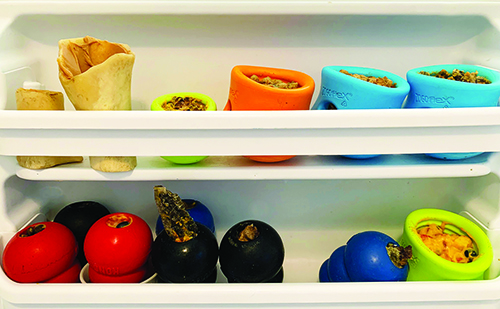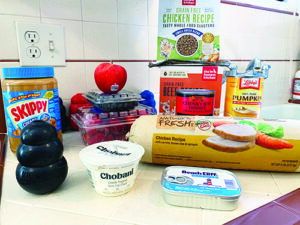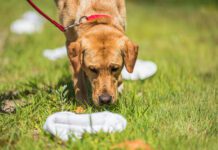
Enrichment toys for dogs are popular, and for several good reasons. They can be great boredom busters, helping to channel a dog’s energy into an acceptable activity. They can slow a dog’s habit of eating too quickly, thus helping prevent choking. And research suggests that dogs may prefer working in some way to obtain their food to eating food that’s readily available in a bowl.
One of the oldest enrichment toys on the market is the Kong, first developed in the 1970s when company founder Joe Markham discovered his German Shepherd’s love of a discarded rubber auto part. The original toy that Markham invented is now considered a classic, easily recognized by its original bright red color and hollow beehive shape. Today, Kong toys are available in a wide variety of shapes, colors, and sizes – and there are just about as many ways to stuff a Kong as there are trainers to think them up!
While the Kong Company is a leader in innovating and refining more and more canine toys that can be stuffed with food, many challengers have brought other exciting food-puzzle toys to market. One of our newer favorites is the Toppl, made by West Paw. Its wide opening is more enticing for those dogs who are put off by the more difficult task of getting food out of the Kong.
Whatever toy you use to hold food for your dog to unpack, these tips will help you stuff the most fun and functionality into the toy for your dog to enjoy:
1. Get the right size. I prefer to start my puppies with whatever size they’ll use as adult dogs, to make sure outgrown toys don’t accidentally become choking hazards later on. And, for pups and young dogs, I use food-dispensing toys to feed the entirety of their meals – I only rarely put their food in a bowl. Any bit of time that they are fully engaged in a safe activity is time I can use to do something else!
The goal, then, is to find a toy of just the right size, or a combination of toys of the right sizes, to contain their meal. This takes some experimentation, and depends on the kind of diet you feed (kibble, canned, rehydrated, commercial raw, or home-prepared).
Classic Kongs come in six different sizes, from XS to XXL. Toppl comes in two sizes (small and large); the two sizes can be used as a pair, with the smaller one inserted into the larger one to create an additional challenge (the dog has to separate them before he can start getting the food out).

2. Teach your dog how to get the food out – and make it easy at first! When first introducing your dog to a food-stuffed Kong, you should make the contents especially tasty and particularly easy for your dog to extract; some dogs lose interest if it’s too difficult to unpack.
Let your dog watch you add a small handful of kibble mixed with some small favorite treats. Excitedly shake the Kong before offering it to your dog. Set the Kong on the ground and gently manipulate it until a few treats fall out. Encourage your dog to interact with the toy and calmly praise his success.
After he understands that moving the toy around can make treats fall out, start adding a smear of peanut butter, creamed cheese, or canned dog food just inside the rim of the toy. Hold the toy for him and manipulate it so that he can reach all the yummy goodness inside with his tongue. Then reload it and put it on the ground for him to try without help.
As long as he’s motivated to work persistently to get the food, you can keep increasing the difficulty of the food-extraction challenge with each food-stuffed toy you offer him. Next, you might pack the toy with wet food or a mix of kibble and something like peanut butter or yogurt; these foods require a combination of licking and tossing or dropping the toy to extract.
Here are some more ways to keep ratcheting up the difficulty of the food-extraction challenge:
If using kibble or other small treats, add a few larger, oddly shaped treats (such as dried beef lung or a large piece of biscuit) that will get in the way of the small treats and require more work to extract the contents.
Tightly pack the contents into the toy. Don’t be afraid to really shove stuff in there! I sometimes use the back end of a butter knife to tightly compact the contents of the toys.
Prepare a number of food-stuffed toys in advance and freeze them for an added challenge and as a cool treat on a hot day. An advantage to freezing is that you can prepare several at once so they’re always on hand when you need one. (Pro Tip: Muffin pans, coffee cups, or ramekins work well to hold Kong toys upside down in the freezer as they set, especially when using liquid contents that might drip.)
Teach your dog to search for treats and toys and then hide the food-stuffed toys somewhere in the house.
Put the food-stuffed toys in a cardboard box or folded-up paper bag and encourage your dog to do whatever it takes to “get the toy!”
3. Be creative and change recipes to retain your dog’s curiosity and interest. Anything that’s safe for a dog to eat can be added to a food-dispensing toy. Kibble, canned dog food, dog treats, fresh fruits and veggies, meats, cheese, yogurt, canned pumpkin, mashed sardines, dry cereal, even select leftovers pulled from the fridge all make great ingredients. (Always introduce new foods in small amounts to help prevent digestive upset.) See the recipes below for some of my dog’s favorite “Kongcoctions.”
4. Make adjustments for dogs who need to count calories or who are on a limited-ingredient diet. If your Westie is watching his waistline, or your Labrador’s diet is limited, stuff their food-dispensing toys with their regular diet, with the addition of perhaps just a few low-calorie treats or tidbits that won’t trigger an allergic reaction.
Here’s a tasty way to increase the appeal of your dog’s usual kibble without adding too many calories: If your dog enjoys peanut butter, whisk a tiny bit into hot water and use the peanut butter water to coat the kibble before stuffing it into the toy.
5. Keep it clean. A quick soak in warm soapy water and an old toothbrush or bottle brush works well to address any remaining food particles stuck inside. Kong and Toppl toys are also safe to wash in the dishwasher (but use the top rack!).
These recipes are simple and easily make enough filling for multiple toys. Much like doing my own meal prep before the start of a busy work week, I set aside about 30 minutes to prepare a “flight” of food-stuffed toys for the freezer. Don’t be afraid to get creative; dogs don’t care about strange combinations. Sardines and blueberries? Sure! Chopped apples on a layer of liverwurst? Why not? Have you seen what dogs pull from the trash and eat? Their food palette is on an entirely different planet than ours when it comes to culinary choices.
Peanut Butter Kibble
Dilute one tablespoon of peanut butter with two tablespoons of hot water. Whisk until combined. Add one cup of kibble. Mix until coated and spoon into toys.
Fruit Salad
Chop dog-safe fruits of choice. (We like apples and assorted berries.) Add directly to toys or stir into a mixture of canned pumpkin and plain yogurt.
Something’s Fishy
Drain a tin of sardines (use the ones that are packed in spring water). Shred the fish with a fork. Mix with pumpkin and yogurt. Spoon into toys. Adding kibble to this mix will stretch the sardine mash a little farther. These are best served outdoors; they are stinky!
Reconstituted Dog Food
I don’t use dehydrated dog food for meals, but I do keep some on hand to use as an easy, healthy meal replacement served out of a toy.





any safety issues regarding stuffing the goodies in cow hooves? My 6 months old standard poodle loves to chew on these but doesn’t chew aggressively, so I haven’t worried about his teeth breaking. the hooves seem soft enough.
Great article, but as there are still (new) dog owners who are unaware of Xylitol-toxicity, please always specify “xylitol-free” peanut butter.
Diana, you beat me to it
As a former Emergency Clinic vet, I can’t count the number of Xylitol toxicities I’ve treated.
Easy cheese (cheese in a can) might also be a useful ingredients.
Why does the author say to use the top shelf of dishwasher? I always put my dog dishes on the lower shelf, so germs do not drip onto dishes below? Is this faulty reasoning?
The manufacturers of some products specify top rack dishwasher safe – apparently the bottom rack can get hot enough to melt plastics and other materials. I wouldn’t worry about germs dripping onto people dishes – the dishwasher is very thorough. Think of a shower – your dirty hair doesn’t leave you with dirty feet. 🙂
As a long time dog owner but newbie to stuffing food in dog toys, thank you for this excellent introduction to get me started. One question though, what kind of plastic/ rubber are these toys made of? And is it safe for consumption? I am thinking of concerns for people ingesting BPA from their water bottles and foods wrapped in plastics and then heated in the microwave transmitting plastic particles into the food. Is anyone else concerned about this?
The toys listed here are safe. The Toppl from West Paw is made of their latex-free Zogoflex material, which is manufactured in the US with materials from the US, is BPA-and-phthalate-free, non-toxic, and FDA-compliant.
The Classic Kongs are made from natural rubber and are manufactured in the United States, but I couldn’t find any official certifications or guarantees on their website for non-toxicity. A brand that makes similar products is SodaPup – they’re also made in the US with natural rubber, but they actually state that their products are non-toxic, FDA-compliant, BPA and phthalate free, and pass Prop 65 testing.
I am surprised to see in the picture Skippy peanut butter. I have always believed you are not supposed to give dogs peanut butter with sugar in it. I always use natural peanut butter with the only ingredient “peanuts.”